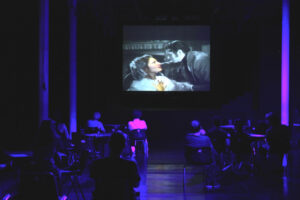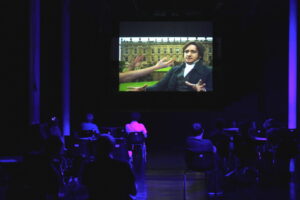Nel 2017 ARTECO ha presentato a Torino, nell’ambito di NESXT – festival diffuso dedicato all’arte contemporanea, due opere dell’artista austriaca Daniela Zahlner: il video Olympieion. Our boodies in ruins è stato proposto in occasione di Carlina on stage, mentre Take me to Pemberley è stato proiettato nell’ambito di Moving Bodies – After Festival.
Come cambia la percezione dei nostri corpi attraverso le tecnologie che ridisegnano, aumentano, preservano, trapiantano e producono artificialmente la nostra realtà fisica? E ancora, che ruolo hanno l’amore e il desiderio in un mondo post-industriale quasi del tutto virtualizzato? Questi gli interrogativi posti dai lavori di Daniela Zahlner e in particolare dal video Take me to Pemberley. Mr. Darcy è il prototipo dell’eroe romantico dal 1813, quando è apparso per la prima volta nel romanzo Pride and Prejudice di Jane Austen. Il libro ha avuto diversi adattamenti cinematografici (in particolare quelli del 1940, 1995 e 2005) che non solo inseriscono il personaggio di Darcy nella cultura popolare, ma illustrano anche le nostre nozioni capitalistiche dell’amore e del desiderio, nonché il desiderio di evasione in un mondo pre-industrializzato e pre-virtualizzato. “Anche io ho ceduto al signor Darcy. Grazie alla mia webcam e al Photo Booth, posso finalmente conquistarlo.”
In 2017 in Turin, as part of NESXT – the multi-venue festival of contemporary art – ARTECO presented two works by the Austrian artist Daniela Zahlner: the video Olympieion. Our Bodies in Ruins was screened on the occasion of Carlina on Stage, while Take me to Pemberley was shown as part of Moving Bodies – After Festival.
How does the perception of our bodies change through the technologies that redraw, augment, preserve, transplant and artificially produce our physical reality? Furthermore, what role do love and desire have in a post-industrial and almost entirely virtualised world? These are the questions posed by the works of Daniela Zahlner and in particular by the video Take me to Pemberley. Mr Darcy has been the prototype of the romantic hero since 1813, when he appeared for the first time in the novel Pride and Prejudice by Jane Austen. The book has had various cinema adaptations (in particular those of 1940, 1995 and 2005) which not only made the Darcy character part of popular culture, but also illustrate our capitalistic notions of love and desire, not to mention the longing for evasion in a pre-industrialised and pre-virtualised world. “I too gave in to Mr Darcy. Thanks to my webcam and to Photo Booth, I can finally conquer him.”
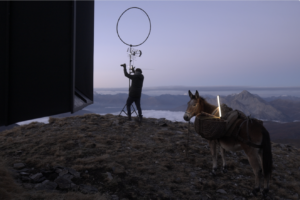
Thermocene. Giorgio Ferrero, Rodolfo Mongitore...
MYBOSSWAS, EX., ARTECO, KINO Produzioni presentano THERMOCENE una mostra di Giorgio Ferrero, Rodolfo Mongitore (Mybosswas) & EX. Thermocene è la {...}
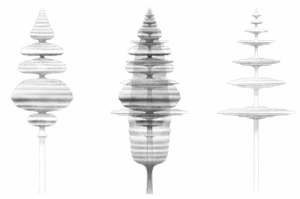
Jacopo Rinaldi. Ardesia
Dal 14 giugno 2025 al 25 gennaio 2026 vi aspettiamo alla Pinacoteca G.A. Levis di Chiomonte, per la mostra personale dell’artista Jacopo Rinaldi, {...}
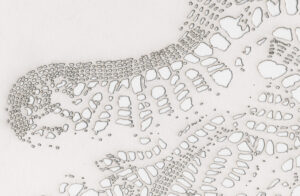
HELENA HLADILOVÁ / La montagna che vide...
Sabato 29 aprile, alla Pinacoteca G.A. Levis di Chiomonte, apre al pubblico la mostra personale dell’artista Helena Hladilová, La Montagna che {...}











